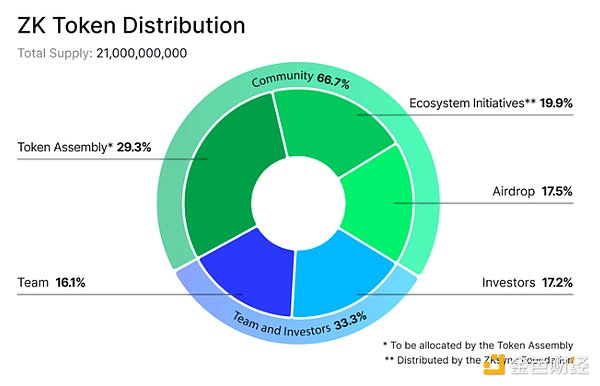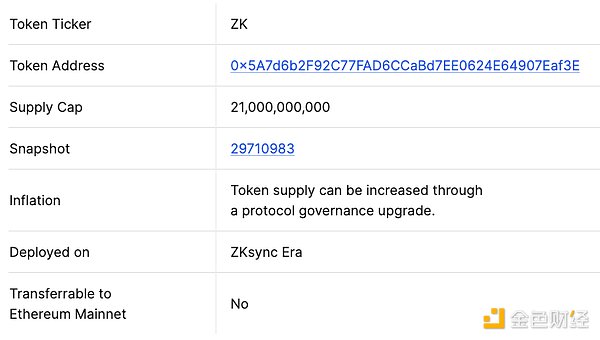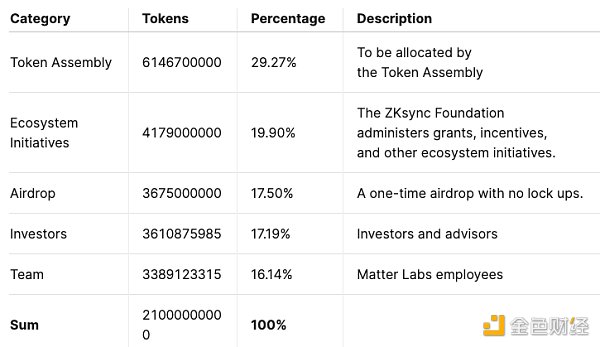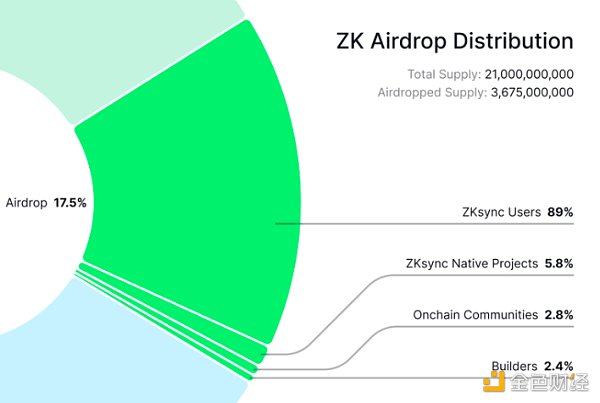Written by: 0xjs@黄金财经
On June 1, 2024, the community-focused zk-rollup L2 zkSync finally announced the details of the token ZK airdrop.
ZK token distribution details

The total supply of ZK tokens is 21 billion, and the token contract is deployed on zkSync Era, with the contract address 0x5A7d6b2F92C77FAD6CCaBd7EE0624E64907Eaf3E.

66.6% of the total supply of ZK is allocated to the community: 17.5% of the total supply of ZK (about 3.675 billion) will be allocated to the community in a one-time airdrop; the rest (49.1%) will be distributed over time through the ecosystem program managed by the ZKsync Foundation and the ZK Nation governance process to support the growing ecosystem as new users come on-chain.
33.3% of the total supply is allocated to investors and the Matter Labs team: 17.2% is allocated to investors; 16.1% is allocated to the Matter Labs team. These ZK tokens are locked for one year and then unlocked in 3 years, from June 2025 to June 2028.

ZK Airdrop Details
According to Matter Labs official information, 17.5% of the total supply of ZK will be airdropped to the community at one time, and the airdropped tokens will not have any vesting or lock-up period and will be fully circulated on the first day.
The crypto community has two ways to obtain this 17.5% airdrop of approximately 3.675 billion ZK.
89% airdropped to users: ZKsync users who transact on ZKsync and reach the activity threshold.
11% airdropped to contributors: individuals, developers, researchers, communities, and companies who contribute to the ZKsync ecosystem and protocol through development, advocacy, or education - regardless of their activity on ZKsync.
Eligibility and allocation of airdrops are based on the ZKsync Era and ZKsync Lite activity snapshot taken at 0:00 UTC on March 24, 2024, marking the first anniversary of the launch of the ZKsync Era mainnet.
According to official news, 695232ge wallet is eligible for airdrops.

Principles of ZK Airdrop
The official blog of zkSync also explained the principles of ZK airdrop. They believe that community is everything, airdrops should be given to real users rather than witches, and how to treat whales.
Community is everything, powering the community
17.5% of the total supply of ZK was airdropped to 695,232 wallets, which is the largest number of tokens distributed to users among major rollups. The airdropped tokens do not have any vesting or lock-up period and can be fully circulated on the first day. This amount is higher than the locked allocation of the Matter Labs team (16.1%) and its investors (17.2%).
The number of tokens awarded in the airdrop is larger than the Matter Labs team and investors, making it more than a symbolic decision for the community. When the ZKsync governance system launches in the coming weeks, the community will have the largest liquid token supply to guide protocol governance upgrades.
Rewarding Real People
A well-designed airdrop rewards community members who actively participate in the network. With 6 million unique addresses on ZKsync Era, it is easy to eliminate bot swarms by applying strict sybil criteria. But sybil detection often uses arbitrary filters to weed out real users. For ZK airdrops, this is an incomplete approach.
ZK airdrops focus on identifying real users using a human-based approach. A wallet’s on-chain history can reveal a lot about the habits of its owner. Real people tend to be risk-takers, especially those who feel part of the community. They spend time on-chain, impersonating, trading, trying new protocols, and holding speculative assets. Bots and opportunists are the opposite. Bots take fewer risks with minimal effort as they try to integrate into the community and extract value from it.
Whale addresses are airdropped up to 100,000 ZK
Real humans are involved. They pool assets together and eventually flow into dApps and DeFi protocols, becoming the lifeblood of a high-liquidity ecosystem. Users should be rewarded accordingly based on their contribution to ZKsync's success.
But there are limits. It is easy for a whale to get a large allocation without any restrictions and then run away. ZK allocation is airdropped up to 100,000 tokens per address. By limiting the number of whales, the ZK token airdrop fairly rewards community members who contribute to ZKsync in different ways.
ZK Airdrop Claiming Steps
Step 1, Eligibility
First, every address that has transacted on ZKsync Era and ZKsync Lite is checked against eligibility criteria that identify people who have taken the time to carefully explore ZKsync. Each address must have at least one credit to be eligible for the airdrop.
Step 2, Allocation
After a wallet’s eligibility is determined, its allocation is calculated based on the crypto assets transferred into ZKsync Era. The formula adjusts the address’ allocation based on the assets the address has in ZKsync Era (in wallets and DeFi) and how long those assets have been in ZKsync Era. Each address’ value-scaling allocation then increases with each additional credit they earn. The more credits earned, the larger the final allocation, capped at 100,000 ZK.
Step 3. Multipliers
Each address can earn multipliers based on activity that indicates a high likelihood of human behavior or contribution to ZKsync. These multipliers apply to ZKsync Era and Lite eligibility and allocations.
Be part of the thriving culture of ZKsync by owning ZKsync native NFTs
Support the ZKsync ecosystem by holding ZKsync native ERC20 tokens
Try out ZKsync Era’s native account abstraction using a smart contract wallet
Receive and hold airdrops from other ETH communities to commit to the long-term success of the network
Transact with popular ETH mainnet smart contracts and explore new use cases and dapps
After step 3, each address will be allocated tokens. Addresses must meet a minimum requirement of 450 ZK and a maximum of 100,000 ZK. Tokens from addresses with less than 450 ZK are recycled back into the pool. Excess tokens from addresses with more than 100,000 ZK are also recycled back into the pool. These tokens are then redistributed to bring the minimum allocation to 917 ZK.
Step 4: Thoughtful Sybil Detection
At this point, the vast majority of Sybils have been naturally eliminated through the eligibility and allocation criteria. Industrial shills play a destructive game. They give very little and gain a lot, like parasites sucking the blood and sweat of the community. The human-first approach flips this asymmetry to benefit real people. It recognizes and rewards users who have done a lot to contribute to the community and added value.
At the end of the allocation process, each wallet goes through an additional sybil detection step to eliminate the most obvious herd attacks. It uses a very conservative heuristic framework on purpose to avoid accidentally punishing real people. This approach can solve some of the issues with complex bots passing through, but value scaling ensures their token allocations remain small.
Step 5: Minting, Claiming, and Delegating
Community members can check eligibility at claim.zknation.io and will be able to claim their tokens starting next week until January 3, 2025.
Eligible GitHub developers and ZKsync GitHub discussion helpers must link their address to their account by 00:00 CEST on June 25th to claim.
External projects, protocol guilds, and ZKsync native project contributors will be able to claim starting June 24th, 2024.
With ZKsync’s native account abstraction, there is no gas cost to claim ZK. Once claimed, token holders can participate in the governance of the ZKsync protocol and delegate their token voting power to themselves or to representatives they believe will continue to advance individual freedom for all.
 ZeZheng
ZeZheng







